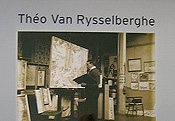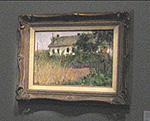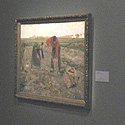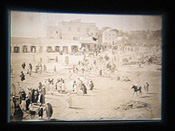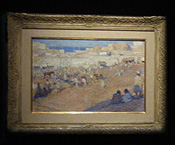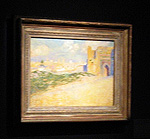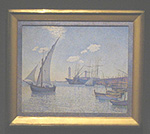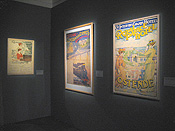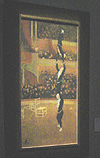The browser will either open the file, download it, or display a dialog.
|
Théo Van Rysselberghe |
||||||||||
|
Brussels proved to be more than just the capital of the European Union this past May when the city hosted three stimulating exhibitions. Art Nouveau Bing, held at the Musées royaux des Beaux-Arts de Belgique, and Yearning for Beauty: The Wiener Werkstätte and the Stoclet House shown at Victor Horta's Palais des Beaux-Arts, were cause for celebration in the art historical community, paying tribute to the work of the savvy dealer, Siegfried Bing, and to the anomaly of Josef Hoffman's Viennese palace having been constructed in Brussels. The third exhibition, also held at the Palais des Beaux-Arts, was a major retrospective of the work of the Belgian artist, Théo Van Rysselberghe (1862-1926), that showed over 200 works by the artist, accompanied by a profusely illustrated catalogue of 260 pages. | ||||||||||
| As one of the major founding members of the Belgian avant-garde exhibition society, Les XX, along with James Ensor, Fernand Khnopff, Georges Lemmen and Henry Van de Velde, Van Rysselberghe is surely not an unknown artist in his native Belgium. Two major retrospectives were organized in his hometown of Ghent and held at the Museum of Fine Arts in 1962 and in 1993.1 The exhibition in 1962 by Paul Eeckhout provided an excellent overview of the career of the artist with its nearly 300 works, in all its multiple facets—painter, etcher, lithographer, illustrator of books and, to a lesser extent, sculptor. The catalogue, although invaluable, was small by today's standards. The exhibition that followed thirty-one years later was deliberately smaller in scale, roughly half the size, and devoted almost entirely to the artist's Neo-Impressionist works and his book arts production. Reflecting this emphasis, the catalogue contained scholarly essays by Jane Block, "Théo Van Rysselberghe peintre aux multiples facettes: Genèse d'un peintre néo-impressionniste," and Adrienne and Luc Fontainas, "Théo Van Rysselberghe et l'ornementation du livre." Ten years after the second Ghent exhibition, in 2003, Ronald Feltkamp published the long-awaited catalogue raisonné of Van Rysselberghe's oeuvre containing 1,700 works as well as offering over 330 color illustrations.2 In 2005 the Musée d'Orsay's comprehensive exhibition, Le Néo-Impressionnisme de Seurat à Paul Klee, showed two portraits by Van Rysselberghe, Signac sur son bateau, and Maria Sèthe à l'harmonium, not included in the current retrospective. Despite all of these fine efforts, and perhaps complicated by the artist's vast output of paintings, book design, prints, posters, decorative arts and sculpture, we still lack a complete understanding of Van Rysselberghe's achievement. | |||||||||||
| The present exhibition, sponsored by the Belgian Art Research Institute and directed by Olivier Bertrand, is ambitious in scope. For those visitors not familiar with the artist's oeuvre it provides an excellent introduction to many phases of his production, from an early watercolor of 1877, Pêcheurs au bord d'une rivière, to his late oil painting of 1925, Sous les gros pins. It also offers a few glimpses into uncharted territory, particularly Van Rysselberghe's three trips to Morocco undertaken in October 1882-November 1883; November 1883-October 1884; and December 1887-March 1888. | |||||||||||
| Organized chronologically, the exhibition leads the viewer through eight major sections reflecting various stages and influences in the artist's career, including rooms devoted to his earliest works; his first two trips to Morocco; his knowledge of James Whistler and the Impressionists; his last voyage to Morocco; his coming under the spell of the French Neo-Impressionist Georges Seurat and his execution of Neo-Impressionist portraits, land and seascapes; his drawings and several posters; his works in Provence, and finally ending with his later move to Saint Clair (fig.1). | |||||||||||
|
The first room containing Van Rysselberghe's earliest productions (roughly 1877-1882) was surprising for the consistently high quality of works produced by such a young artist. Two masterful naturalist canvases, Dans les choux and la récolte de pommes de terre, complemented the work that dominated the room, En West-Flandre, measuring 136 x 200.6 cm (fig. 2 and 3). All of these paintings include figures in landscapes and suggest the narrative manner of the French painter, Jules Bastien-Lepage. | ||||||||||
| The second gallery featured works executed during Van Rysselberghe's first two trips to Morocco. Van Rysselberghe was following in the immediate tradition of his teacher, Jean-François Portaels, Director of the Academy of Fine Arts in Brussels who had traveled to Morocco in the mid-1840s, and who encouraged his pupils to travel to exotic North Africa. Of course, French artists such as Eugène Fromentin, Théodore Chassériau and Eugène Delacroix were drawn to North Africa as well. Among the nine works by Van Rysselberghe shown in the gallery, the Garde au repos, with its astonishing informality of pose, and Savetiers arabs (Fondak à Tanger), are two new discoveries not included in the catalogue raisonné. Van Ryselberghe was clearly fascinated by scenes of every day life, which he recorded in more than thirty paintings and drawings. Unfortunately, Fantasia: jeux de la poudre, Maroc, the artist's major work from the period, was not lent by the Musées royaux des Beaux-Arts de Belgique due to its fragility. Following its exhibition in 1885 at the second annual Les XX show, the Belgian government accorded it the honor of buying it. Van Rysselberghe himself was aware of its importance, not only because of its size, his largest to date, but also to his artistic development because of the lightening of his palette and the sense of excitement generated through the movement of the central rider. | |||||||||||
| The third gallery was devoted to the years 1884-1886, when Van Rysselberghe responded to the dual influences of James Whistler and the French Impressionists. Among the works in the room are his double portrait, Jeanne et Marguerite S. [chlobach] of 1885, and his two portraits of Camille Van Mons. The earliest of the three, the Schlobach sisters, seem artificially posed and stiff when compared to either portrait of Camille. Yet, the refinement of the color palette and the artist's exploration of exquisite tonalities of black and gray recall Whistler. In the first portrait showing Camille standing before a Japanese print, the artist's interest in ordering the composition and the exploration of the subtleties of black are also reminiscent of the work of Whistler. The freer brushstrokes as opposed to those of the Schlobach sisters reveal the artist's more recent interest in the Impressionists whose work he knew even before they showed at Les XX in 1886. The later portrait of Camille Van Mons seated is actually a portrait-pendant to a standing Marguerite, Camille's younger sister, unfortunately not on display. It is equally surprising that neither the catalogue raisonné nor the exhibition contained the pendant to the 1885 standing portrait of Camille—another of her sister Marguerite, (private collection), also dressed in black and posed before a Japanese screen. This gallery also included examples of Van Rysselberghe's elusive dabbling in the decorative arts, a silver ladle and two knives and forks for a fish course, and a pendant with pearl on a silver chain made for Madeleine Maus, wife of the Secretary of Les XX, Octave Maus. More research needs to be devoted to this aspect of Van Rysselberghe's career in which he joined fellow Vingtistes, Lemmen, Van de Velde and Willy Finch in enlarging the definition of the fine arts in the 1890s through the addition of furniture, jewelry, and stained glass to the artistic canon. | |||||||||||
| The next gallery contained seven works from Van Rysselberghe's third and last voyage to Morocco as well as a remarkable grouping of photographs taken by the artist (fig. 4). In juxtaposing the documentary photographs with Van Rysselberghe's works, we can see the scenes that captivated his imagination, such as the teeming market place in his Le grand sokko, Tanger (fig. 5). In addition, we realize how his earlier work, Fantasia, captured the frenetic excitement engendered by the spectacle of riders. Van Rysselberghe used these photographs as an aide-mémoire for his canvases. The third Moroccan visit was actually an official diplomatic trip undertaken with the art patron, Edmond Picard, who agreed to accompany the Belgian ambassador, Baron Whettnall, to Meknes. The small train, dubbed La Marocaine, which was offered to Sultan Hassan the First, can be seen in one of the photographs on display. The photograph provides the added visual treat of showing the artist aboard the train. This photograph and another showing the Ambassador and his delegation (including Picard and Van Rysselberghe) had been published previously in a small monograph on Van Rysselberghe issued in 1963.3 However, the majority of the one hundred or so photographs contained in Van Rysselberghe's album have never been published. The photographs may also have served the artist in preparing some of his drawings that accompanied Picard's published account of the diplomatic mission, El Moghreb-al-aksa, 1889. In La porte de Mansour el Hàlij [Méquinez] of 1887, we witness one of Van Rysselberghe's first experiments with Neo-Impressionism and see the technique fully developed in his 1888 Campement devant Méquinez, which the artist presented to his host in Morocco, Baron Whettnall, as a gift of gratitude. (fig. 6) | |||||||||||
| Van Rysselberghe first became acquainted with the work of Georges Seurat at the eighth and last Impressionist exhibition held in Paris in May, 1886. Because of the uproar in Paris of Un dimanche après-midi sur l'île de la Grande Jatte, the Secretary of Les XX, Octave Maus, invited Seurat to show at the annual exhibition of Les XX held in Brussels in February of 1887. Seurat was happy to accept the invitation and sent La Grande Jatte along with six paintings of the Normandy coast. Although Van Rysselberghe was not the first member of Les XX to produce a work predicated on the theories of color and line promulgated by Seurat (that distinction falls to Willy Finch), he nonetheless became the most devoted and sustaining Belgian practitioner of the style—in a sense, the Belgian counterpart to Paul Signac. As one by one the Vingtistes—Van de Velde, Finch, Lemmen and Dario de Regoyos—abandoned divisionism, Van Rysselberghe remained committed to it. Fortunately, the exhibition was able to include the artist's first pointillist oil portrait, Mademoiselle Alice Sèthe, 1888, which also heralded his career as a portrait painter (fig. 7). By melding an avant-garde technique with the classical tradition of portraiture, he produced a work reflecting the material opulence of his particular sitter as well as the world of the artist. In later portraits, such as Emile Verhaeren dans son cabinet of 1892 and Mlle Irma Sèthe, sister of Alice, from 1894, the compositions become more daring and the technique more assured. It is regrettable that the portrait of Maria Sèthe, the third sister, and future Madame Henry Van de Velde, could not be lent. Omissions such as these are much regretted by the organizer of the exhibition (see Olivier Bertrand's introductory essay in the catalogue) and do not reveal a specific curatorial point of view, but rather reflect the inaccessibility of some of the works. However, the breathtaking Conté crayon drawing, Intimité, depicting Maria sewing, reveals Van Rysselberghe as a master of the medium evoking Symbolist associations. Also to be regretted was the absence of Van Rysselberghe's portrait masterpiece of eight of his close friends, La Lecture, from 1903. The painting depicts the celebrated poet, Emile Verhaeren (1865-1916), reading aloud to a group of seven distinguished auditors. Completed some sixteen years after the introduction of the revolutionary work of Seurat into Brussels, it is the fitting climax, if not the swan song, of the Belgian pointillist tradition. It stands as the artist's final and most ambitious work in this medium; but alas, it stands in the Museum of Fine Arts, Ghent, rather than here.4 Also missing is En juillet, avant midi, 1890, which is a tour de force of Van Rysselberhge's ability to integrate figures in a landscape. Combining clearly identifiable depictions of Maria Sèthe Van de Velde, and the artist's wife, Maria Monnom Van Rysselberghe, it is a hybrid genre of portrait and landscape, but also something more—a portrait of the social and cultural environment of the artist and his friends. | |||||||||||
|
While Van Rysselberghe created Neo-Impressionist portraits of his friends and family, he also developed Neo-Impressionist marinescapes of great beauty. The exhibition reveals that 1892 was, indeed, a very good year for the artist as he produced L'Escaut en amont d'Anvers: un Soir; L'Escaut en amont d'Anvers: après le brouillard; Le port de Cette, les tartanes (fig. 8); and Côte de la Manche. The year also saw Van Rysselberghe's friendship with Paul Signac blossom. In late March, Van Rysselberghe accompanied Signac on a trip to Southern France. Specifically, Le port de Cette, les tartanes dates from this joint voyage, but L'Escaut en amont d'Anvers: un Soir shows that Van Rysselberghe was already influenced by the magic of the poetry and lyricism of Signac's Concarneau. Pêche à la sardine, Opus 221 (adagio). | ||||||||||
| From time to time, the organizers of the exhibition brought in comparative works such as Alfred Willy Finch's Les Falaises au Southforeland, 1892, to contrast with Van Rysselberghe's Côte de la Manche of the same year. While it is illustrative to see how another Belgian pointillist attacked a scene of the English Channel, these paintings are very different in mood and organization. Perhaps a more telling comparison could have been made with the work by another fellow Vingtiste, Georges Lemmen, in his La Tamise, L'élévateur, which shares a similar moisture-laden atmosphere and Symbolist mood. A pity also is the lack of one of Van Rysselberghe's earliest pointillist seascapes, La pointe de Per Kiridec à Roscoff, executed in 1889. Although gratifying to see, Près des Rocs de Per Kiridec à Roscoff, another loan from the artist's trip to Brittany, is much smaller and more tentative. One year later, Les Dunes à Kadzand shows Van Rysselberghe focused more on surface pattern and abstraction, while in his L'Arc en Ciel from later in 1893, we are given an astonishing perspectival viewpoint of land and sea conjoining. This sense of a dramatic perspective is explored again in the artist's Canal en Flandre, for which only an oil painting that predates the pointillist canvas appears. Nonetheless, the preparatory work gives us a sense of near vertigo with its diagonal sweep of riverbank and trees leaning inward towards the water's edge. Works such as these were much appreciated in Vienna by artists such as Gustav Klimt when Van Rysselberghe showed at the Secession and became known there through the issue devoted to him in their periodical, Ver Sacrum.5 | |||||||||||
| Van Rysselberghe began working in 1895 on a grand canvas, l'Heure embrasée (Provence), depicting female bathers on a monumental scale frolicking in the water and at the water's edge on the Mediterranean coast. Undoubtedly, this was Van Rysselberghe's reply to the ambitious canvases of Au temps d'harmonie by Signac and l'Air du soir by his friend, Henri-Edmond Cross. This painting also marked the beginning of Van Rysselberghe's divergence from Neo-Impressionist color theory. Although the catalog indicates that the painting was to be included, it did not travel from the Staatliche Kunstsammlungen in Weimar to Brussels. Its absence is strongly regretted but we can judge something of the artist's evolution by his adoption of large mosaics of color freely applied, and a return to an interest in drawing in his La Pointe St-Pierre à St-Tropez. It was this new painting style that led to important decorative commissions for Van Rysselberghe, such as those for the Hôtel Solvay in 1902 and 1913. Van Rysselberghe also executed decorative compositions in 1910 for the Villa Noccard in Neuilly (paintings in the exhibit, Au pied du grand escalier, étude, and Après la baignade) and in 1917 for Leon Guinotte's Château de Pachy. Of interest also is that Adolphe Stoclet was eager to have Van Rysselberghe participate in the decoration of the Stoclet House. However, Van Rysselberghe confided to Henry van de Velde that he found the house to be totally to his disliking and that "he would prefer to spend his life in a peasant's hut rather than in this sterile palace."6 Again, more research needs to be done on these commissions and Van Rysselberghe's place within the context of such French "decorative" painters as Pierre Bonnard and Edouard Vuillard. | |||||||||||
|
Two areas in which Van Rysselberghe excelled, posters and the book arts, were only meagerly represented in the exhibition, which seems to reflect a deliberate curatorial decision (fig. 9). Van Rysselberghe was one of the principal artists responsible for the revitalization of the book arts in Belgium and this was a missed opportunity to remind viewers of Van Rysselberghe's significant accomplishments in this domain. This reviewer explored the artistic and cultural context of Van Rysselberghe as a book designer in Stephen Goddard's exhibition Les XX and the Belgian Avant-Garde: prints, Drawings, and Books ca. 1890, and Adrienne and Luc Fontainas have published an excellent catalogue raisonné on Van Rysselberghe's book ornamentation.7 The posters on display included one of a series he executed for the Compagnie Internationale des Grands Hôtels, Royal Palace Hotel Ostende, a commission obtained through his brother, Octave, architect for the company; and Quelques Maîtres de la musique vocale. Autre séances données par Madame Marie Mockel. These two lithographs, as interesting as they might be, do not reveal the strength of the artist as a poster designer and it is surprising that none of his justly well-known posters—for the art dealer, Lembrée, or any of those for La Libre Esthétique, in 1896, 1897, or 1904—were on display. | ||||||||||
|
One of the most beautiful sections of the exhibitions was a group of Conté crayon drawings: Intimité, Emile Verhaeren en septembre 1892 à Hemixen (Anvers) and Maria Van Rysselberghe de profil. In addition, pastels of Acrobates, Musicienne, Joseph Mommen and Ida Braun gave the viewer an opportunity to see the delicacy and refined color sense of the artist (fig. 10). | ||||||||||
| The last portion of the retrospective, to my mind, was filled with far too many minor works having more to do with market forces than with scholarship. The artist would have benefited from a much more judicious selection covering his later years. These were spent intermittently beginning in 1911 in the South of France in Saint Clair. In 1920 Théo moved permanently into the house constructed by his brother, Octave, where he died in 1926. | |||||||||||
| A beautifully illustrated catalogue accompanied the exhibition, which is a major accomplishment and will help to advance Van Rysselberghe scholarship. The arrangement of the texts do not echo the exhibition's installation and are arranged into ten topics: Van Rysselberghe's Moroccan period (Khadija Jlaidi); his friendship with Octave Maus (Olivier Bertrand); an overview of his career (Patricia Vander Elst-Alexandre); his relationship with Emile Verhaeren (Véronique Jago-Antoine); his role within Les XX and the Parisian Independents (Claire Maingon); his works displayed at the Paris Salons (Dominique Lobstein); his friendship with Paul Signac (Marina Ferretti Bocquillon); his affinity with Henri-Edmond Cross (Claire Maingon); his kinship with André Gide (Peter Schnyder); and an analysis of his prints (Pascal de Sadeleer). It would have been extremely helpful to have even a rudimentary index to the catalog. The back cover of the exhibition catalog reveals that the Belgian Art Research Institute is preparing a catalogue raisonné in three volumes, and a critical edition of five volumes of Van Rysselberghe's letters. Van Rysselberghe was a prolific writer whose beautiful handwriting is a work of art in itself. Recently Catherine Gide, granddaughter of the painter, published letters from her grandfather to Maria Zimmern Petrie, a sculptor-friend for whom Van Rysselberghe executed two portraits and also a selection of letters to André Gide (chosen by Peter Schnyder).8 Documents such as these give us insight into the working habits of the artist, his views on other artists and much more. The edition under way by the Belgian Art Research Institute would be a most welcome addition to the scholarly literature. | |||||||||||
| Despite my criticisms of the Théo Van Rysselberghe exhibition, I believe that the show was admirably installed and its twin goals met. The exhibition served to acquaint the public with the work of this significant yet still not fully appreciated artist, while the catalogue provides a lasting contribution to scholarship. What remains to be accomplished is a meaningful assessment of Van Rysselberghe's role within European art of the late nineteenth and early twentieth centuries. His principal activities within Les XX as a talent scout, his contributions as a portraitist and landscape and marine painter within the avant-garde movement, Neo-Impressionism, and his role as a catalyst in the renaissance of the book arts and poster-mania in Belgium need to be balanced against his more classically conservative later works in the tradition of Puvis de Chavannes. Standing upon the work of previous scholars, the Belgian Art Research Institute has initiated this re-evaluation process. I look forward eagerly to their findings. | |||||||||||
| Dr. Jane Block, Andrew Turyn Professor University of Illinois-Urbana/Champaign |
|||||||||||
|
My thanks to Pascal de Sadeleer for sharing his knowledge of the artist with me and for providing me with a private tour of the exhibition. 1. Paul Eeckhout, Rétrospective Théo Van Rysselberghe. Ghent: Musée des Beaux-Arts, 1962 and Robert Hoozee, Théo Van Rysselberghe: néo-impressionniste. Antwerp: Pandora, 1993. 2. Ronald Feltkamp, Théo Van Rysselberghe, 1862-1926, Brussels: Editions Racine, 2003. 3. Guy Pogu, Théo Van Rysselberghe, sa vie: dans le cadre des recherches techniques et psycho-sociales des causes de l'art. Paris: Premiers Eléments, 1963. 4. For more on this painting, see Jane Block's, "Twee Sleutelwerken van Théo Van Rysselberghe," in 200 Jaar Verzamelen: Collectieboek Museum voor Schone Kunsten Gent. Ghent: Ludion, 2000,195-201. 5. Emile Verhaeren, "Theo Van Rysselberghe," Ver Sacrum, II (1899): 1-31. 6. Van Rysselberghe to Henry Van de Velde, Bibliothèque Royale Albert 1er, Musée de la Littérature, Fonds Van de Velde, FSX800. 7. Jane Block, "Book Design among the Vingtistes: The work of Lemmen, van de Velde, and Van Rysselberghe at the Fin-de siècle," The University of Kansas, Spencer Museum of Art, 1993, 98-125. Adrienne and Luc Fontainas. Théo Van Rysselberghe: L'Ornement du Livre, Cahier 3, Antwerp: Pandora, 1997. De Sadeleer displayed and published a cover by Pierre Kropotkine, La Morale Anarchiste, which was not included in the Fontainas catalogue raisonné. As de Sadeleer points out on p. 195, fn26, the cover was first reproduced by Erik Buelinckx in his contribution to the volume Anarchisten rond Emile Verhaeren. Brussels: VUBPress, 2005, 80. 8. Catherine Gide et al, Théo Van Rysselberghe Intime. Le Lavandou: Réseau Lalan, 2005. |
|||||||||||


